Best Waterproof Cameras: Find the perfect compact for your holiday backpack

If you think your smartphone is good enough to capture the best bits of your summer holiday, think again.
Not all handsets feature a tough, rugged or waterproof design, and dropping them in the sand – or worse, the pool – could leave you with a costly repair or replacement bill when you get home.
So what’s the answer? Ruggedised compact cameras. Their robust designs and weather seals allow you to take them into a pool without a second thought. Better still, they’re made to be virtually indestructible so you can hand them over to kids without worrying about damage.
In this round-up, we’ve pulled together six of the toughest cameras you can buy right now, from Nikon, Panasonic, Fujifilm, Olympus, Ricoh and GoPro.
After subjecting them to various tests, we found the best waterproof camera to be the Olympus Tough TG-5, which can shoot in the versatile Raw format, and has an outstanding spec with excellent image quality. If you’re on a stricter budget, then the Fujifilm XP130 performs well for a cheaper model.
Related: Best cameras
1. Olympus Tough TG-5
The best stills-focused waterproof camera you can buy
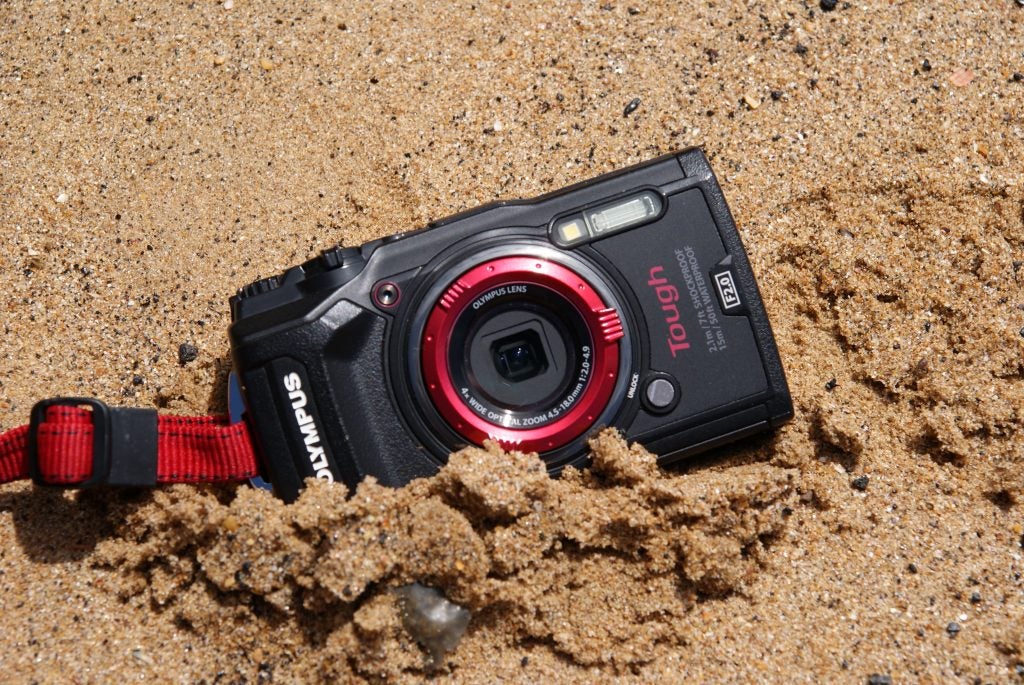
Pros:
- Excellent photo quality
- 4K and slo-mo video recording
- Sensors aplenty
- Virtually indestructible
Cons:
- Limited zoom range
- Pricey for a compact
Why we liked the Olympus Tough TG-5
The Olympus Tough TG-5 is one of the newer releases in the world of tough compacts and its key selling point is that, unlike others in this roundup, it can shoot in the versatile Raw format.
Its 12-megapixel sensor uses larger pixels than the 16-megapixel sensors used by most rival rugged compacts. Combine this with the lens’ comparatively bright f/2.0 aperture, and the result is improved low-light performance.
Images taken in less than ideal conditions (such as underwater) look cleaner and more detailed than those of rivals, and even if the performance in good outdoor lighting isn’t especially amazing by premium compact camera standards, it’s still crisper and more vibrant than the rugged alternatives.
Macro shots, in particular, look fetching and detail-rich, while the 4K and 120fps slow-motion video options are welcome. Photo enthusiasts, meanwhile, will appreciate the inclusion of that Raw file support and a wide array of manual shooting options.
On the design and features front, the TG-5’s clever lens arrangement allows for a range of optional add-ons such as a macro light or fisheye lens, while the inclusion of GPS and a compass, manometer and thermometer allows all sorts of extra info to be embedded into photos taken while on your adventures.
While it isn’t particularly cheap, the TG-5’s strong showing with both features and performance make it the standout camera in the tough compact category. If you’re looking for the best waterproof point-and-shoot, and don’t mind the lack of a built-in viewfinder, look no further.
Read the full review
Latest live deals
2. Panasonic Lumix FT7
If you need a viewfinder, this is the best waterproof compact around
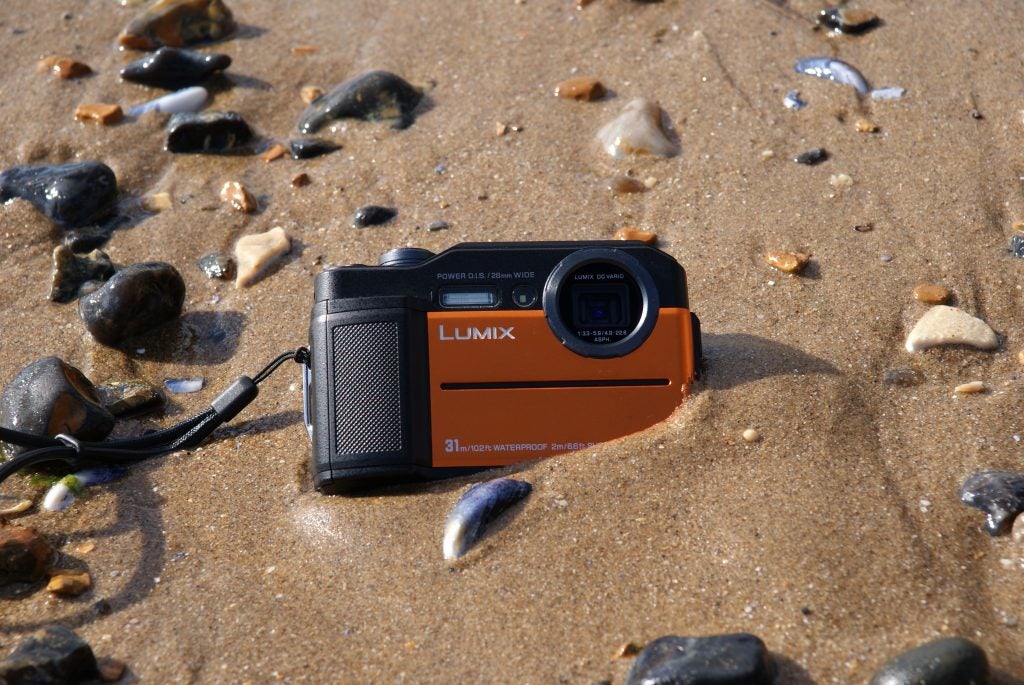
Pros:
- Excellent waterproofing
- Electronic viewfinder
- Decent image quality
Cons:
- No RAW shooting
- No built-in GPS
- Controls can be fiddly
Why we liked the Panasonic Lumix FT7
The Panasonic FT7 is a little larger than most waterproof compacts thanks to its electronic viewfinder, which gives you a valuable second means of composing your shots – one that’s particularly handy to have on a sunny day when glare makes the screen difficult to use.
It uses a 1/2.3-inch sensor, like most of the other models here, although this one has a relatively high 20.4 megapixels. That means the camera – which features a decent 4.6x optical zoom range – delivers finely detailed images in good lighting.
It doesn’t have the ultra-sensitive sensor pixels and wide f/2.8 aperture of the Olympus TG-5 though, which means it’s less impressive in low light, while the lack of RAW support means you won’t have as much scope for editing your shots to fix noise and other issues as you would on the Olympus.
4K and high-speed video capture are both available here, but we found the 1080p at 60fps mode to be more reliable than either – the 4K’s extra detail isn’t necessarily impactful enough to warrant its slower 30fps shutter speed, while the 720p video of the high-speed mode is very soft and lacking in detail.
The FT7 comes with better water resistance than any of the other cameras here – it’s rated waterproof to a depth of 31m, which gives it an notable edge over the Olympus for scuba divers. Aside from that and its viewfinder, it doesn’t offer any other compelling reasons to buy it over the Olympus – but it is a strong alternative in the rugged camera field.
Read the full review
Latest live deals
3. Nikon Coolpix W300
A waterproof camera that can dive deeper than most
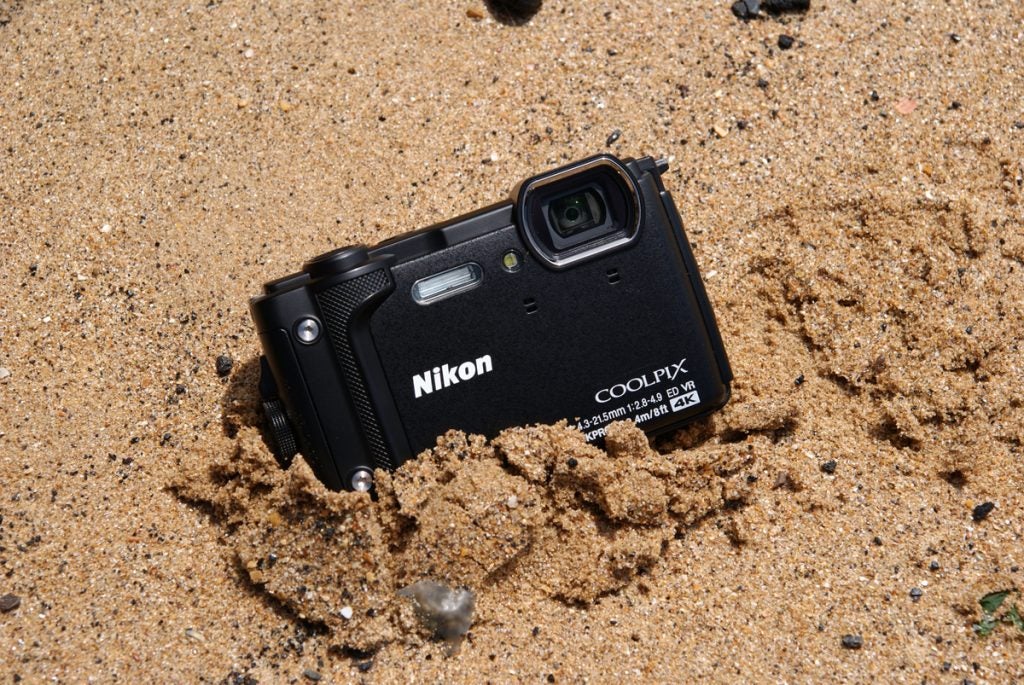
Pros:
- Tough, waterproof construction
- Simple operation
- Built-in GPS
- Strong image quality in good light
Cons:
- Reflective screen
- No option to shoot in Raw
- Not as strong as rivals in low light
Why we liked the Nikon Coolpix W300
The W300 is Nikon’s attempt at delivering a point-and-shoot compact camera that ticks both the ‘premium’ and ‘rugged’ boxes. In reality, it falls short of its ambitions with the former, even if it nails the latter.
Waterproof to a depth of 30 metres, freeze-proof to -10ºC, dust-proof, and guaranteed to withstand a drop of up to 2.4m onto a hard surface, this camera is impressively tough – even if our review sample managed to pick up a distracting scratch on its 3-inch LCD screen’s surface merely from riding in a backpack.
To boost its outdoorsy credentials, it’s equipped with onboard GPS/GLONASS and a depth gauge, altimeter, barometer and compass to furnish images with all manner of location information. Plus, a torch button and motion controls – the latter to make using the W300 possible while diving or wearing thick winter gloves.
It also comes with 4K video recording, a 5x optical zoom lens and Wi-Fi and Bluetooth, which makes for an impressive feature list. However, the W300’s image quality doesn’t quite live up to its premium billing. In sunny outdoor conditions, the camera’s JPEGs look sharp and vibrant at a glance, but closer inspection reveals a lack of definition around the edges of the frame.
Shooting in low light results in noisy, grainy photos that lack detail. Unlike the Olympus TG-5, there’s no option to shoot in Raw either, which limits the degree to which you can “fix” the photo quality.
Unless you really need that extra few metres of waterproof protection, the Olympus TG-5 or Panasonic FT7 make for a much better buy.
Read the full review
Latest live deals
4. GoPro Hero 7 Black
The best camera for shooting video beneath the waves
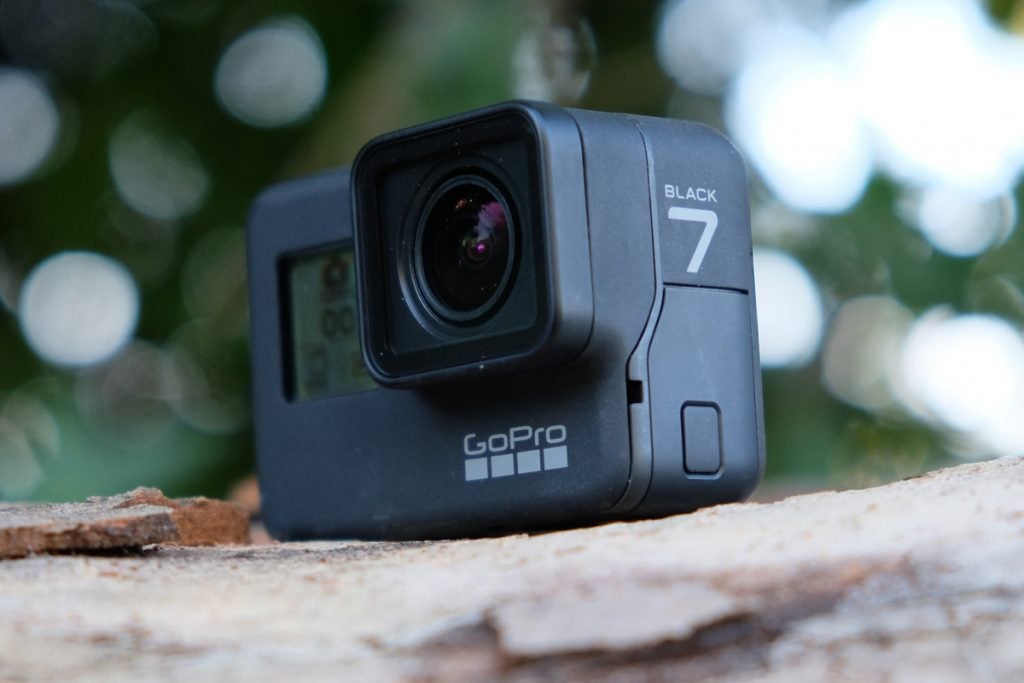
Pros:
- Excellent image stabilisation
- Improved audio quality
- Big selection of mounts and accessories
- Waterproof to 10m without a case
- Now offers livestreaming
Cons:
- Still relatively expensive
- Occasionally sluggish UI
Why we liked the
The Hero 6 Black proved that GoPros aren’t just for video and the Hero 7 Black has taken its photo-shooting skills further, making it the best all-round action cam you can buy.
This new flagship adds a SuperPhoto feature, which helps it automatically adjust picture settings like white balance according to the scene you’re shooting (for example, when snorkelling or skiing). Its 12-megapixel photos are very good, as long as you’re shooting in decent light with HDR switched on, even if they’re not quite as clean as those from rivals such as the Olympus TG-5 at low ISOs.
Like the Hero 6 Black, you can remove the distinctive fisheye look of stills photos and video by switching to ‘Linear’ mode, which gives you straight horizons and removes barrel distortion. Sadly, you can’t shoot in Raw when in this mode, but Raw support is available for other still modes if you need some extra editing flexibility.
The Hero 7 Black is the best GoPro so far for video too, largely thanks to its new HyperSmooth stabilisation. This builds on the already excellent electronic stabilisation seen on its predecessor, making handheld shots look like they were shot with a gimbal. Handily, it now works with its maximum 4K/60fps shooting mode, while an improved microphone and live-streaming powers offer extra video support.
If you’re looking for a waterproof all-rounder, the Hero 7 Black is an excellent little camera. It’s waterproof down to ten metres without a case, and while it can’t quite match the photo quality of more stills-focused cameras like the Olympus TG-5, it compensates with its video quality and near infinite array of mounting options.
Read the full review
Latest live deals
5. Fujifilm FinePix XP130
A fine waterproof camera for those on a budget
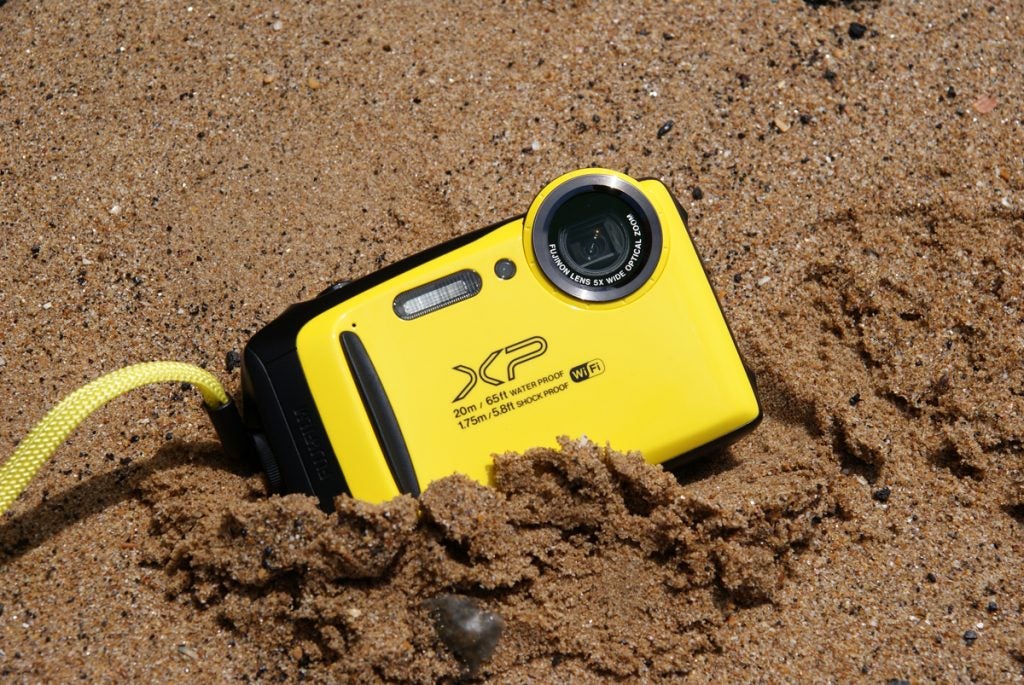
Pros:
- Simple to use
- More affordable than other rugged cameras
- Pocket-sized
Cons:
- Average image quality
- No 4K video recording
- Light on features compared to rivals
Why we liked the Fujifilm FinePix XP130
The most affordable of the rugged waterproof cameras that we’ve tested, the Fujifilm XP130 costs less than £150 while offering a similar level of survivability to far pricier cameras from Ricoh, Olympus and Nikon. It’s waterproof to 20 metres, dust-proof, freeze-proof to -10ºC and will survive drops of up to 1.75 metres onto a hard surface.
The downside, at least in comparison to the Nikon and Olympus models, is a paucity of features. The premium tough cameras come with GPS, compass and more built-in, but Fujifilm has elected not to include them here. You do get Bluetooth and Wi-Fi, in order to pair the camera with your phone (which will enable GPS geotagging), while the 3-inch LCD is pretty good, allowing you to frame and review your shots with sharp detail – even in bright sunlight.
Image quality isn’t bad for an entry-level camera, with the detail and colour in JPEG photos almost matching up to the quality of the more expensive Nikon W300. Both cameras have 16-megapixel, 1/2.3-inch sensors that do an acceptable job in decent lighting conditions, but fail to deliver fine detail and punchy contrast in gloomier situations. Video, meanwhile, is limited to 1080p rather than 4K, but does run at a smooth 60fps – faster than the 1080p footage of the more expensive Ricoh WG-50.
While its performance and features do little to excite, the Fujifilm FinePix XP130 lives up to its billing as a rugged compact camera – and does so at a low price. For those just looking for a cheap point-and-shoot that will document (and survive) the family holiday, it’s a great choice.
Read the full review
Latest live deals
6. Ricoh WG-50
The tough cam with a taste for macro shooting

Pros:
- Lightweight, compact and tough construction
- Great macro shooting performance
- Wide choice of shooting modes
Cons:
- Sluggish autofocus
- No zoom rocker
- Unattractive styling
Why we liked the Ricoh WG-50
Ricoh’s tough, waterproof camera sits in something of a unique position: it’s quite a bit more affordable than premium rugged models such as the Olympus TG-5 and Nikon W300, but quite a bit more expensive than entry-level models such as the Fujifilm XP130. This wouldn’t be a problem if it offered something over the latter. However, aside from an excellent macro shooting mode – aided by a ring of six LEDs niftily placed around the lens, which ensures subjects as close as a centimetre are evenly lit – it fails to do so.
In terms of features the WG-50 offers a 5x optical zoom lens, 16-megapixel CMOS sensor, Full HD video recording and a 2.7-inch LCD screen. In addition, it has a rock-solid build that’s resistant against water, dust, freezing temperatures, accidental drops and up to 100kg of pressure.
It’s certainly nigh-on indestructible, but in general its performance as a camera doesn’t outstrip that of the Fujifilm XP130, which costs around £100 less. Autofocus and zoom speed feel more sluggish than we’d like, 1080p video recording is capped at 30fps (the XP130 manages a smoother 60fps), and still images, while fine at a glance, exhibit some noticeable purple and green fringing upon closer inspection. It doesn’t even have built-in Wi-Fi or Bluetooth, which all the other models here do.
Most people will be better off with either the cheaper Fujifilm XP130 or the better-equipped, better-performing Olympus TG-5. However, lovers of extreme close-ups should consider the Ricoh WG-50 for its clever built-in macro light.
Read the full review
Latest live deals
Best Waterproof Camera Round Up
- Olympus Tough TG-5: Best for stills
- Panasonic Lumix FT7: Best with a viewfinder
- Nikon Coolpix W300: Best for depth
- GoPro Hero 7 Black: Best for video
- Fuji FinePix XP130: Best for budgets
- Ricoh WG-50: Best for macro
How we test waterproof compact cameras
Each of the compacts in this roundup was subjected to the same stringent tests.
- Each camera was run through the lab, this reveals the level of detail the sensor resolves and offers a clear indication of its noise response at high sensitivity settings.
- The cameras were used both outdoors and indoors to get an idea on the reliability of their exposure systems
- We test each camera underwater in a swimming pool
- We do a drop test from arm’s length onto a solid concrete floor
Waterproof compact camera jargon explained
Sensor:
Compared with DSLRs and mirrorless cameras that feature large sensors, the tough compacts in this roundup feature much smaller 1/2.3-inch sensors. This is the smallest sensor that’s commonly used in cameras today. For snapshots in good lighting conditions the results are perfectly acceptable, but they can start to show their weakness in low light and don’t offer much in the way of highlight/shadow recovery.
Wi-Fi:
You’ll find Wi-Fi connectivity features on most but not all tough compacts. If you’d like to transfer images to a mobile device, before sharing them via social media or email, look for one that’s Wi-Fi equipped. The manufacturers apps vary in their levels of sophistication. Some will allow you to take remote control of the camera and fire the shutter directly from the app.
Variable aperture:
All the compacts in this roundup have what are known as ‘variable aperture lenses’; you’ll often find this printed on the body or close to the lens. For example, f/2.0-f/4.9 will be noted on the lens barrel as 1:2.0-4.9. In this instance, the 2.0 and 4.9 figures refer to the maximum and minimum aperture the lens can achieve at either end of the zoom range.
Raw:
You won’t find many tough compacts on the market that allow you to shoot in the Raw format. The benefit of having Raw format recording available is that it gives you greater leverage when it comes to returning detail, controlling noise and editing images on the computer. The only cameras to offer such capability in this roundup are the Olympus Tough TG-5 and GoPro Hero 6 Black, although it’s not available in the latter’s ‘Linear’ mode.
USB charging:
These days, we see more and more cameras support USB charging and it’s an excellent feature to have. The batteries tough compacts use can be quite small, and thus battery life can be rather short. To ensure you don’t run out of power, most manufacturers equip their models with USB charging so you can top up as you go using a power bank or car charger.
FPS:
This refers to the number of frames per second (FPS) the camera can record in a continuous burst. Having a tough compact that shoots at a fast frame rate is important, particularly if you’d like to increase your chances of capturing a spur-of-the-moment shot at the optimum time. A camera that shoots at 10fps or faster will give you the option to cherry-pick your favourite images from a selection of shots taken over a short period of time.


